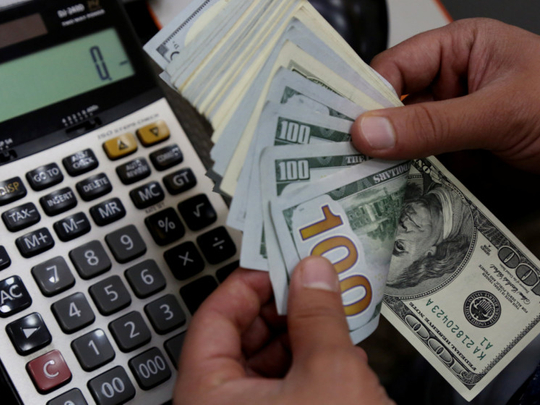
New York
Some foreign-exchange strategists who are still coming to grips with the dollar’s rally recommend staying away from it altogether.
That’s the advice from Canadian Imperial Bank of Commerce, whose bearish outlook for the US currency is at odds with its consensus-defying, 4.6 per cent climb since mid-April. Rather than engaging with the greenback, CIBC’s Bipan Rai recommends focusing on foreign-exchange pairs that don’t include the dollar.
Doing so offers investors a way to manoeuvre the US currency’s rally, which CIBC’s Rai reckons is probably a result of short-covering rather than a structural shift, while also keeping an eye on what he sees as the big picture — a robust global growth environment that should benefit currencies such as the euro.
“Sometimes markets can get confused by what can be a tactical trend rather than a more substantial trend,” said Rai, an FX and macro strategist.
The dollar rose against a basket of peers on Friday and was on pace to finish the week at its strongest since mid-November, as commodity-linked currencies fell following a slump in oil prices and as political concerns in Italy and Spain hurt the euro.
The dollar index, which measures the greenback against a basket of six currencies, was up 0.44 per cent at 94.166, after hitting a high of 94.249, its strongest since mid-November. The index was up 0.6 per cent for the week.
The Bloomberg dollar index is up almost 1 per cent this year, following an 8.5 per cent decline in 2017. The currency’s rebound has led hedge funds and other speculators to trim their net futures short positions, which touched a five-year high in April.
The dollar had been rising for weeks but lost some of its momentum after the Federal Reserve minutes on Wednesday were seen as more dovish than markets had expected.
On Friday, the dollar was supported by data showing new orders for key US-made capital goods increased more than expected in April and shipments rebounded, suggesting that business spending on equipment was picking up after slowing down at the end of the first quarter.
Rai sees value in commodity-linked currencies as crude oil builds on a 14 per cent year-to-date rally. CIBC expects the Australian dollar to rise to 1.12 against the New Zealand dollar in the next couple of months, from just above 1.09 currently.
Compelling franc
The Swiss franc is also a compelling bet given the market’s overly dovish view of the Swiss National Bank’s monetary-policy tightening path, according to Rai. CIBC sees a “very good chance” the SNB will raise rates next year, following the European Central Bank. Haven flows into the currency amid a fraught geopolitical outlook offer another tailwind, said Rai.
While the market has turned “sceptical” on the prospect of synchronised global growth that captivated currency traders at the start of the year, CIBC expects that theme to re-emerge by year-end. Expansion abroad should push the euro to $1.23 by the end of 2018, from about $1.17 now, according to Rai.
But until positioning-squaring in the dollar wraps up, the bank is steering clear.
“The strategic view hasn’t changed,” said Rai. But “we’re not in the business of calling the bottom or catching the knife when it’s falling.”
“We are seeing a bit of a rebound on the crosses, particularly against the commodity-linked currencies,” said Karl Schamotta, director of global product and market strategy at Cambridge Global Payments.
“That’s really, really helping support the US dollar on a trade-weighted basis,” he said.
The US dollar was 0.75 per cent higher against the Canadian dollar, a more than two-week high. The Australian dollar was 0.37 per cent lower against the greenback.
Meanwhile, the euro weakened and was set for a sixth consecutive week of losses as rising bond yields in Italy triggered nervousness among investors, while brewing political instability in Spain also weighed on sentiment.
Spain’s socialist leader Pedro Sanchez on Friday said his party would call a snap election if it won the motion it put forward against Prime Minister Mariano Rajoy over a graft case involving members of his People’s Party.
The news sparked a sharp sell-off in Spanish bonds and stocks, and provided investors with a fresh incentive to get out of Italian assets, which have been rattled by the prospect of a spendthrift coalition government comprising the anti-establishment 5-Star Movement and far-right League.
“Risk premia are rising across the euro area,” said Schamotta. “Market participants are taking the threat of divisions in the euro area more seriously than they have in a long time.” Sterling traded near a five-month low of $1.33 on Friday, hindered by worries over Brexit and further signs of sustained weakness in Britain’s economy.












